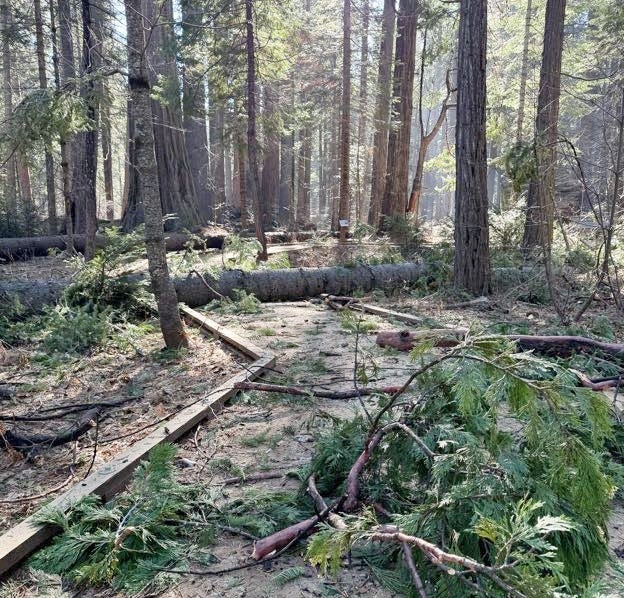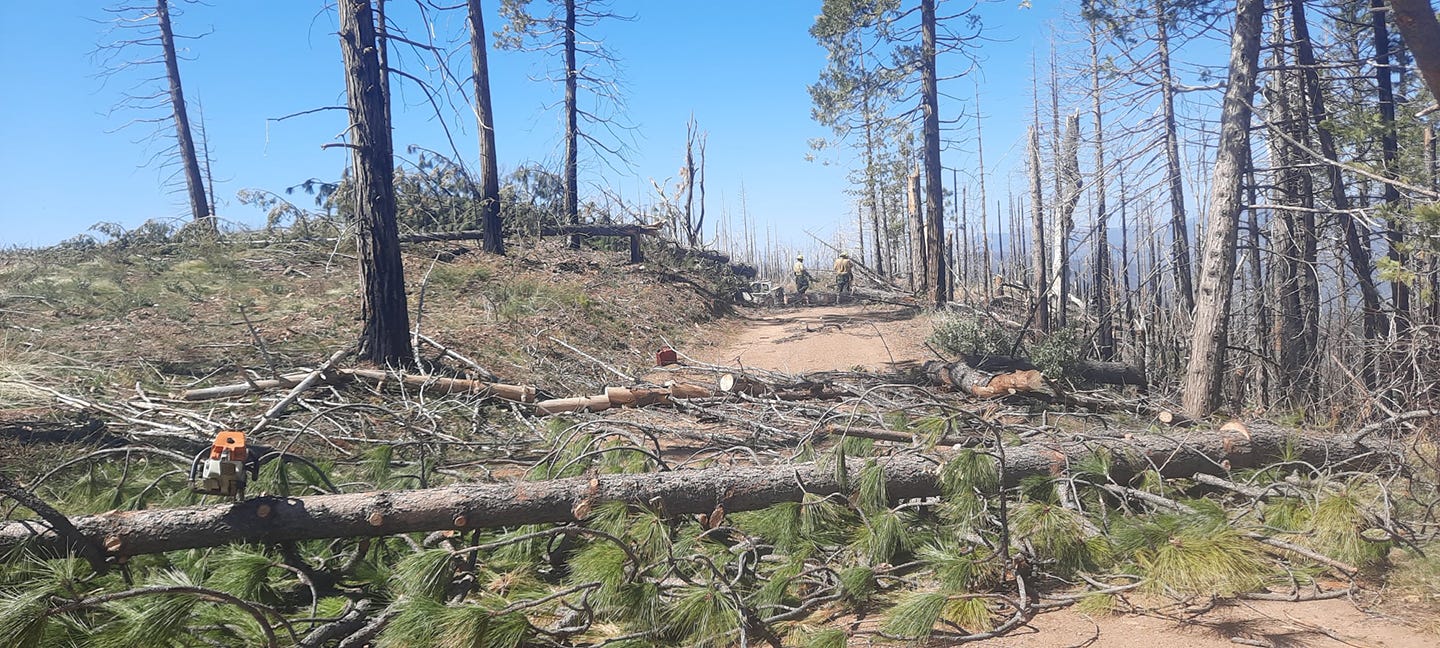Wind and fire
'Devil winds' fan the flames
Volume 3, Number 40 - Thursday, Jan. 9, 2025
Published every Monday and Thursday

Perspective
IT’S HARD TO EVEN THINK about giant sequoias when so many people are impacted by what I think should be called firestorms in Southern California.
Yet I am reminded that we saw similar firestorms in the Sierra Nevada just a few years ago.
With those fires, we lost so many giant sequoias. As the USGS reported HERE, “in 2020 and 2021 alone, wildfires killed approximately 13 to 19% of all large giant sequoias in their native range.”
A common denominator seems to be low humidity and wind.
I wondered about the wind while we were getting warnings about extraordinary Santa Ana wind events before the Southern California fires kicked off earlier this week.
There are differing ideas about how the Santa Ana winds got their name.
According to an FAQ page put together by Robert Fovell, emeritus professor at UCLA (read it HERE):
The most common explanation has the wind being named for the Santa Ana Canyon in Southern California's Orange County, which discounts its rather more regional scope and impact. However, alternative explanations are much more dubious. It is often claimed that "Santa Ana" is a corrupted version of "Santana" which is purported to mean "devil" in Spanish or an Indian language. Yet, the Spanish word for devil is "diablo" and its Satan is "Satana," conspicuously missing an extra "n." The Indian language in which "Santana" means devil has not yet been identified. I am not a linguist, but I suggest it is more likely for a term like "Santana" to have evolved from "Santa Ana" than vice-versa (think "San Francisco" becoming "Frisco" or "New Orleans" devolving into "N'orleans"). References to Mexican General Santa Anna have also been made. All I'm fairly sure of it's not likely named after the feast day of Santa Ana in the Catholic calendar as that falls in July, outside of Santa Ana season.
Given all that expert information about the name, I am still inclined to think of the Santa Anas — and other Katabatics — as “devil winds” because they do so much damage.
Katabatics, you may know, are downslope winds “caused by the flow of an elevated, high-density air mass into a lower-density air mass below under the force of gravity,” as explained by Wikipedia HERE.
Perhaps not noticed in recent news is that as the National Weather Service earlier this week was forecasting “life-threatening and destructive winds” in Southern California — NY Times, HERE (gift link) — weather forecasters in Central California were warning of Mono Winds Monday night that could bring “highway speed gusts to the Sierra Nevada.” Read more HERE.
Mono Winds are another Kabatic wind.
As reported in February 2021 by KRON4 TV HERE, a Mono wind event at Yosemite National Park on Jan. 19, 2021, “produced winds over 80 mph and toppled at least 15 giant sequoias in the famed Mariposa Grove. And then, the past week brought several feet of snow.
Mariposa County Supervisor Miles Menetrey told the reporter that “We’ve never had the destruction that this event brought to our area.
We do know that wind took down trees in the Sierra Nevada. Earlier this week Calaveras Big Trees State Park reported trees down from a recent windstorm. Undoubtedly, there are other examples, and some we won’t know about until spring.


When I visited Nelder Grove on Sierra National Forest in June 2024 (read more HERE), I saw the aftermath of the January 2021 Mono wind blowdown event that dropped hundreds of trees there.
While living on the Oregon Coast, I experienced a Kabatic wind known locally as the “Chetco Effect” — named for the river. The Chetco Bar Fire of 2017 is believed to have started as a lightning strike in a wilderness area and was fanned by the Kabatic wind to burn more than three months and cover 191,125 acres.
I think of these winds as “devil winds,” and in news reports today, there are suggestions that the increased intensity of the recent wind in Southern California is due to climate change.
A news report from UCLA today (HERE) has been referenced in numerous news reports around the world.
According to the report:
• Hydroclimate whiplash – rapid swings between intensely wet and dangerously dry weather – has already increased globally due to climate change, with further large increases expected as warming continues, according to a team of researchers led by UCLA’s Daniel Swain.
• The “expanding atmospheric sponge,” or the atmosphere’s ability to evaporate, absorb and release 7% more water for every degree Celsius the planet warms, is a key driver of the whiplash.
• Co-management of extreme rainfall or extreme droughts, rather than approaching each in isolation, is necessary to find interventions and solutions, researchers said.
A website I recently discovered, called Science Media Centre, on Monday published “expert reaction to LA wildfires.”
One of the experts cited, a wildfire scientist at the UK Centre for Ecology and Hydrology said (in part) that she believed that “while it is too early to link the current Los Angeles fires to climate change” but added, “our research has shown that global warming brings more prolonged dry conditions that exacerbate the spread of wildfires.”
You can read more from scientists commenting on the recent fires HERE.
As noted below, more sunny dry weather is forecast for the Sierra Nevada and Southern California in the next few days. I sincerely hope conditions may change and bring us a normal winter with snow in the mountains.
If not, I’m sure you know, the conditions in the Sierra Nevada — with lots of vegetation growth over the past two wet years — may bring firestorms again.
The current fires in Southern California are still burning. We can understand the conditions that led to what can only be called a conflagration, but we don’t yet know what first ignited the fires.
What we can be sure of, I’m afraid, is that these fires will have a long-lasting impact on the entire state. As with other terrible fires, people will be displaced. Our state, already short on housing, has lost even more. Jobs are lost, and I do not doubt that the latest firestorm will create more difficulty with the insurance crisis we’re already facing.
Wildfire, water & weather update
Sunny and dry weather continues throughout the Sierra Nevada for at least the next several days. Unfortunately.
California’s Fire Weather map HERE shows only areas in Southern California under a Red Flag Warning.
Did you know you can comment here?
It’s easy to comment on items in this newsletter. Just scroll down, and you’ll find a comment box. You’re invited to join the conversation!
Thanks for reading!

